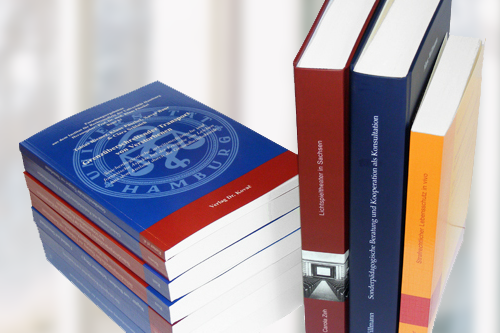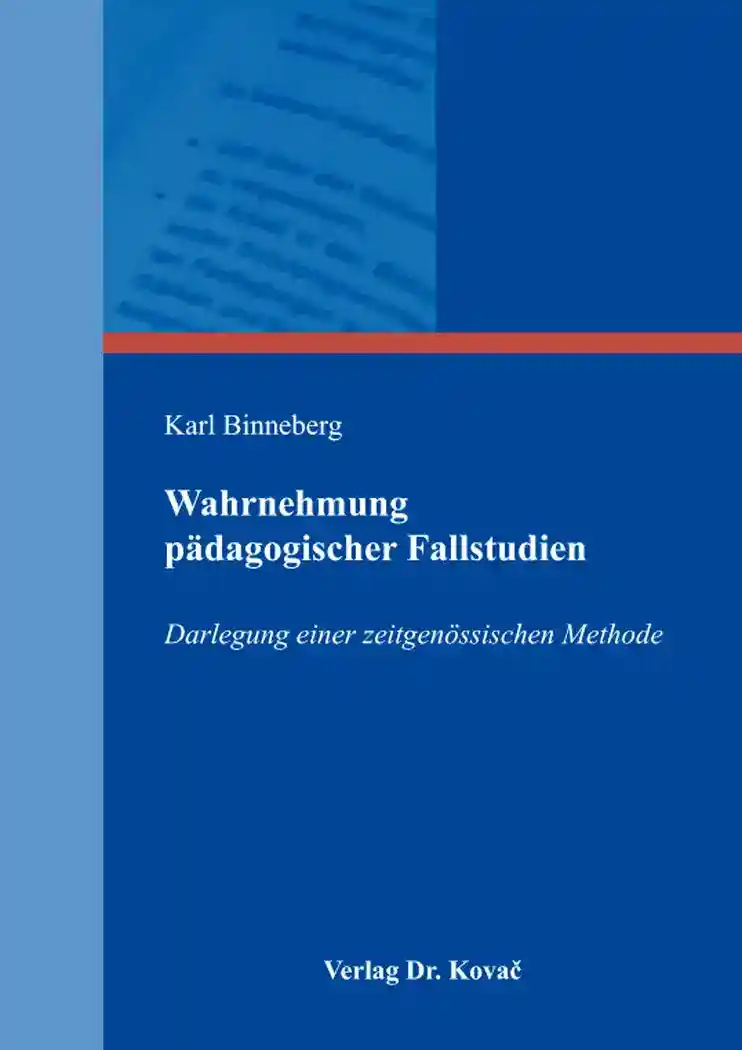Karl BinnebergWahrnehmung pädagogischer Fallstudien
Darlegung einer zeitgenössischen Methode
Schriften zur Pädagogischen Theorie, volume 10
Hamburg 2017, 120 pages
ISBN 978-3-8300-8869-1 (print) |ISBN 978-3-339-08869-7 (eBook)
Rezensionen
[...] der bestechenden Argumentation, vorbildlichen Klarheit und Einfachheit der Ausdrucksweise [...], vorausgesetzt, dass man einen langen und guten Willen hat und einen länger andauernden Gedankengang verfolgen kann. Dies wird dadurch erleichtert, weil auch der Autor sich an ein zentrales didaktisches Prinzip in der Wissenschaft hält, nämlich an die Forderung, Klarheit und Verständlichkeit der wissenschaftlichen Sprache zu verwirklichen.
[...] Karl Binneberg hat einen lesenswerten, zum Nachdenken anregenden Band vorgelegt. Wenn auch die inzwischen theoretisch und methodologisch fortgeschrittenen Erkenntnisse fallrekonstruktiver Verfahren in den Sozial- und Geisteswissenschaften im Hintergrund verbleiben, so werden gerade die für die pädagogischen Fallstudien zentralen Fragen ihrer Grundlegung und Bedeutung, aber auch ihrer Grenzen und Herausforderungen deutlich gemacht. Sowohl für die Praktiker als auch für die mit Fallstudien befassten Forschenden der Disziplin bietet der überschaubare Band vielfältige Anregungen und Perspektiven.
About this book deutschenglish
The new book by author Karl Binneberg carries the main title “Perception of educational case studies” and the subtitle “Statement of a contemporary method”. It begins with a brilliant piece, “Pleading for educational case studies”. The world-renowned pedagogue Wolfgang Klafki termed this introductory plea as a showpiece and emphatically stated that he would call it to his colleagues’ attention. But wherein lie the special possibilities of the casuistic method when it ventures with notable insistency to closely study individual cases? To answer this question, one might attempt a realistic and pragmatic estimation of its possibilities as a methodological hypothesis in the following manner:
The educational casuistry
- can firstly, in the outcome of individual cases, contribute to the conception of hypotheses and theories through theoretical analysis that we use to systemize, interpret and explain educational occurrences that encounter us in reality and texts of all kinds;
- it can secondly, through in-depth case studies that do not shy away from details, contribute to the explanation, improvement and expansion of existing hypotheses and theories in order to observe and describe, explain and classify systematically the educational occurrences and processes more appropriately than before;
- it can thirdly contribute to the correction and revision of hypotheses and theories when, after repeated casuistic testing, they prove themselves to be fragmentary and generalized, indefinite and inappropriate;
- and it can fourthly serve as an orientation for educational practitioners’ actions, by direct introduction into the interplay between exacting theory and not too briefly interpreted practical application.
The comprehensive second chapter of the book contains seven profound treatises concerning the content and method of educational casuistry: In all treatises the knowledge of both literature and specific expertise is superb. A methodological interjection shows the contemporary exposition of the casuistic method. It is also striking to discover the thoughts of Aristoteles in the treatises of the educational casuistry as well as the analogical method and even Kant’s casuistry in “Kant as a Casuist” (W. I. Matson).
Six excellent case-studies in the third and last chapter give the book an outstanding status. The last and outstanding case-study deals with Walter Kempowski’s brilliant “Unser Herr Böckelmann” (Our Mr. Böckelmann). It describes the way 6–7 year-old students see their teacher, whom they call “Mr. Böckelmann”. The scenic description of the relationship between Mr. Böckelmann and his students is full of humour. This led Professor Lassahn, the editor of the magazine “Pädagogische Rundschau” (Educational Observer) to the following brief statement: “The text contains humour that is a scarce commodity in educational works. When you hinted that I would enjoy reading this text, you properly guessed my reaction” (Letter of 3rd September 2014). A similar recognition is given by Michael Rücker, editor of the publisher Peter Lang, who read the study with the same enjoyment as Professor Lassahn.
The second highlight within this case-study lies in Kempowski’s question concerning the human soul: “Die Seele – Was ist die Seele?” (“The Soul – What is the Soul?”). The only way to answer this question sensibly today is to evaluate brain research. The most extensive work in this area is the book published by Norbert Elsner and Gerd Lür “The brain and its Spirit” (Göttingen, 2000). Here the educationalist will find the most important discourses from Günther Patzig (“Body and Soul – the Aristotelian paradigm”), Norbert Elsner (“The Search for the Place of the Soul”) and Andreas Kemmerling (“I, my brain and my bpirit: Real differences or false terms”).
Keywords
AristotelesCarl Friedrich von WeizsäckerCommon SenseErziehungswissenschaftFallstudieGünter PatzigHans-Hermann GroothoffHans-Martin GaugerKasusitikLogikMoralPädagogikSprachanalyseWalter KempowskiWolfgang KlafkiIhr Werk im Verlag Dr. Kovač

Möchten Sie Ihre wissenschaftliche Arbeit publizieren? Erfahren Sie mehr über unsere günstigen Konditionen und unseren Service für Autorinnen und Autoren.

